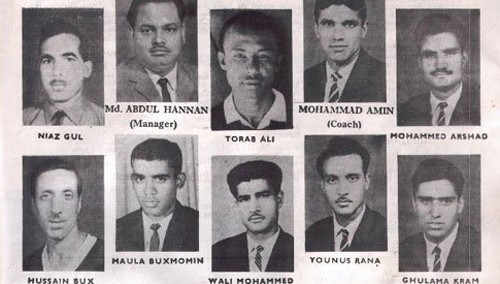

Today, the boys playing street football tournaments in Lyari, that corner of Karachi where the game is still the keystone of life for many, they turn out with each team wearing the same yellow and blue colours of Brazil.
Their dreams today are borrowed from a different country, another continent. The names of Brazilian heroes, Pele, Socrates, Ronaldinho, appear on their shirts. Few, if any of these teenagers would have heard of Qayyum Ali Changezi, the graceful Hazara player from Quetta who through much of the 1950s ranked as Pakistan’s greatest footballer.
Despite setbacks stemming from a lack of resources for the Pakistan Football Federation, established in December 1947 with Mohammad Ali Jinnah as its patron, Changezi -- still revered among the Hazara community even if he has faded into obscurity for most of us -- played a key role in Pakistan’s 2ndplace finish, behind India, in three Colombo Cup contests featuring South Asian teams, and played in 1953, 1954 and 1955.
He also featured prominently in the 1960 Asia Cup qualifiers, in which Pakistan finished in an honourable third place, defeating Iran, 4-1, India 1-0 and drawing 2-2 with Israel, in a game that almost certainly would not have been played today.
Through the 1950s, and, indeed, into the next decade, the centres of footballing power in the country were clearly defined: Karachi, Quetta and Dhaka. The game in East Pakistan was notably well organised, with the loss of that wing after 1970 delivering a huge blow to the sport.
Each national team in the 1950s included players from the Eastern wing, with names such as those of Turab Ali, Moosa Ghazi, and Murad Bakhsh, ranking as among the heroes.
Many of the best players in the country, including Abdul Ghafoor Majna, known as the ‘Pakistani Pele’ or the ‘Black Pearl’ played for the Dhaka League. Majna, dominant in the 1960s when he captained the Pakistan team, had begun to gain fame as a player with huge skill in the late 1950s.
In those days, when international football teams toured the country and the Pakistan team travelled abroad, Majna helped notch up the highly respectable results it recorded against the then Soviet Union, China, Turkey and others -- even if actual victories were few.
The faded pictures of Changezi, Majna, and their team mates shaking hands with dignitaries or lined up in crisp blazers still exist. But the men wearing them have themselves been largely forgotten. Historically, we do not treat our sporting heroes well. When Majna died in 2012 in Lyari, there was barely a media mention of his demise. Suffering the effects of a stroke, he died in poverty and without help from beyond his family. Today, his name would ring few bells beyond Lyari.
The footballing promise of the 1950s and 1960s, too, did not hold out long. While football is played widely in the country, with games visible in many places, Pakistan has never achieved even Asian-level success since those early decades. Even then, financial constraints, politics within the PFF and the fact that the game had only a limited following, held it back. So did the fact that many of Pakistan’s players played barefoot, rather than in footballing studs, a distinct disadvantage and sometimes a source of disqualification at international tournaments.
The toe-hold on the game that Pakistan had shown it may be able to acquire soon slipped away. The rise of other sports in the 1960s, notably squash and cricket, was a factor in this as was the continuing success of hockey.
These three sports appeared to pull audiences, and with them any hopes of patronage away from football. While there were periods when things looked up, Pakistan today stands nowhere in the global fraternity of the world’s most popular sport. Smaller, more impoverished nations from Africa, Latin America, and other parts of the world have left on the football fields of the world a far more distinct set of prints. More continue to appear, but at international level, none bear any trace of the green and white colours of Pakistan.
We can account for this by looking back to the 1950s. Enough effort was not made to take the sport beyond Sindh and Balochistan, the two provinces which, with East Pakistan, featured most prominently in national contests.
Petty politics, too, hindered development. But players of the calibre seen in the 1950s and 1960s have never again stepped onto a field in Pakistan’s stripe. And this, of course, explains why the boys playing the game in Lyari or other shanty towns must look across oceans for their heroes. After all, for decades, they have been none to look towards at home, with only a few now even familiar with the names of the men who gave Pakistan its short-lived status as a nation with footballing promise.